dbltree
Super Moderator
Brassicas are a very easy to grow and inexpensive source of quality forage for whitetails although in cases where there is plenty of other food sources, deer may refuse to touch them. This thread is meant to answer most common questions about growing brassicas. The following is a quick reference of what and how I plant brassicas:
Welter Seed
Albert Lea Seed
Adams - Briscoe Seed Company
Ernst Seeds
MAXI-RACK Seed
Cooper Seeds
Seedland Brassica seed
Star Seed
Deer Creek Seed
Links to growing brassicas
Brassicas for fall grazing
Fall and winter grazing
Brassica Fodder Crops for Fall Grazing
Turnip
Brassicas and Mustards for Cover Cropping
Brassica types:
There are 4 basic types of brassicas that we use in food plots and those are divided into two groups:
Short season brassicas have a 60-90 growing season so we plant them in late July to early August in the midwest.
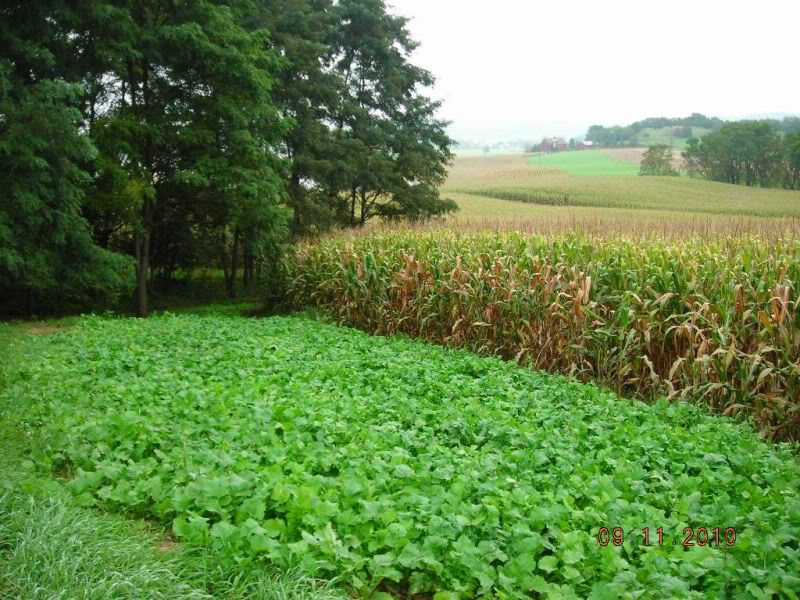
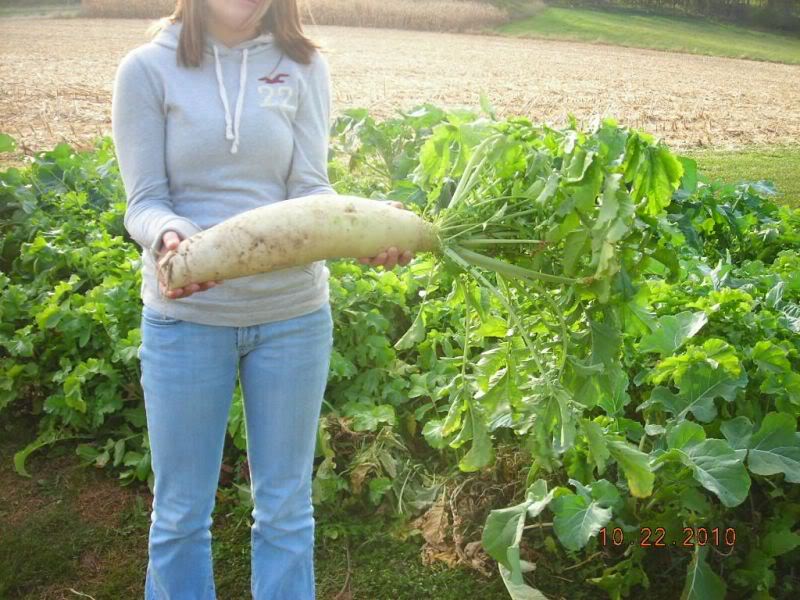
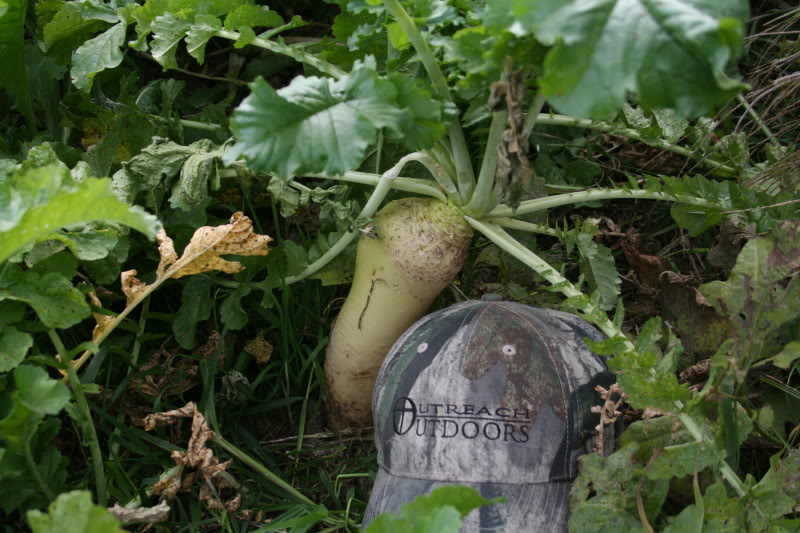
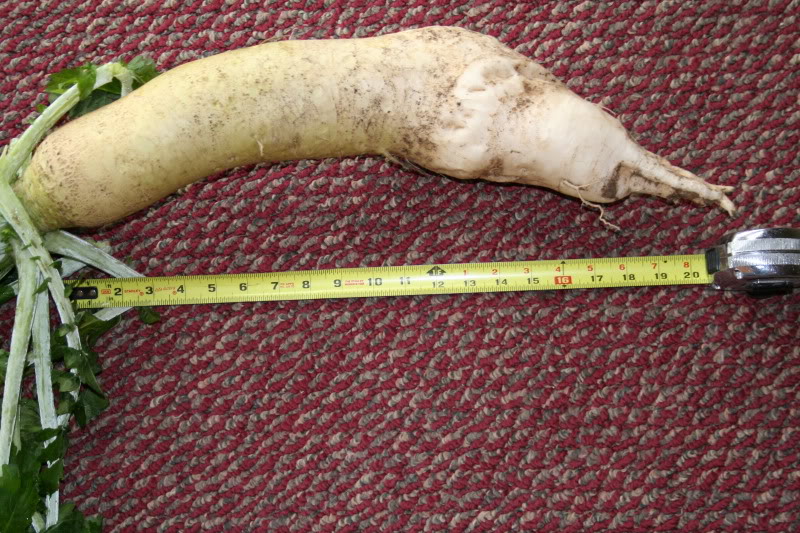
Heavily grazed forage radish
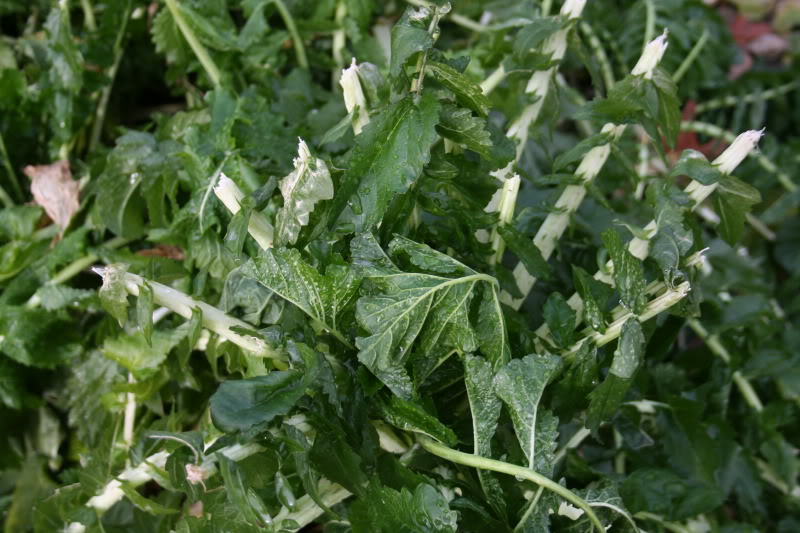
Tillage Radish
Ampac - Groundhog Tillage Radish
It doesn't look a whole lot different and deer and livestock forage on the leaves just like other brassicas, the difference is in the extremely long root.
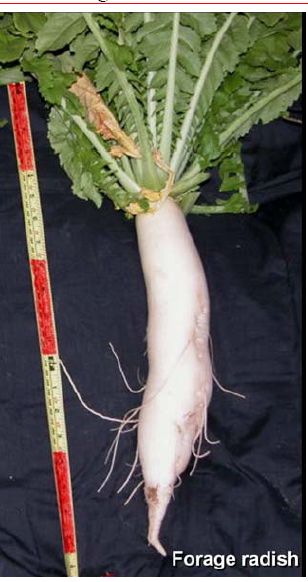
Many of us have very hard pan clay soils that we are trying to improve by various soil building methods and Forage Radishes are a fantastic, simple and economical way of loosening soil, bringing up nutrients from the sub soil and feeding deer at the same time.
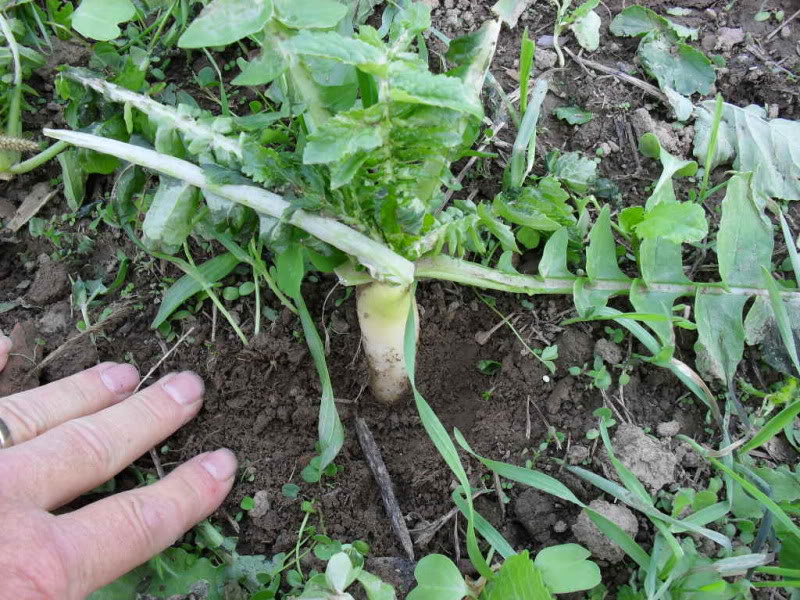
The tops don't look much different then other brassicas but I find deer hammer them even when they won't eat other brassicas.
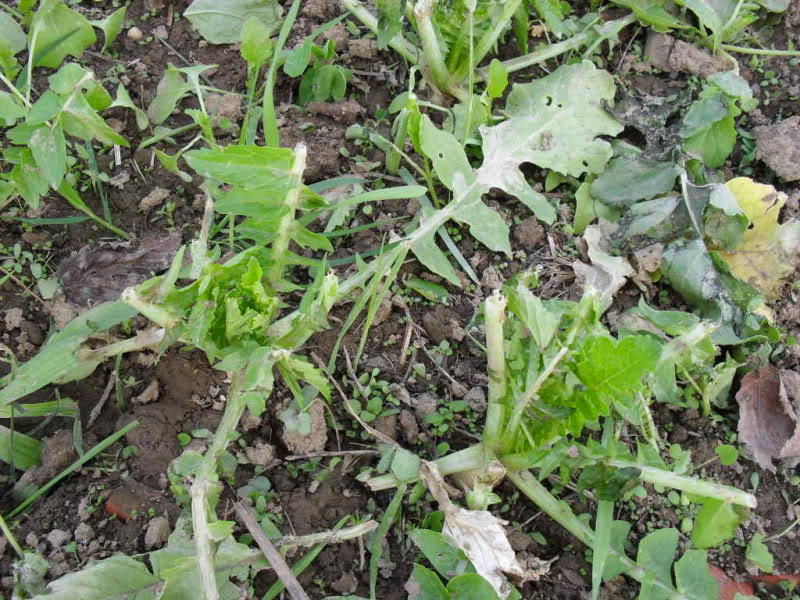
The following spring however the rotted tap roots will leave deep holes that will have shattered the hard pan. Water runs into the holes, the freezing and thawing breaks up compacted soils.
In the fall though the tender foliage attracts whitetails!
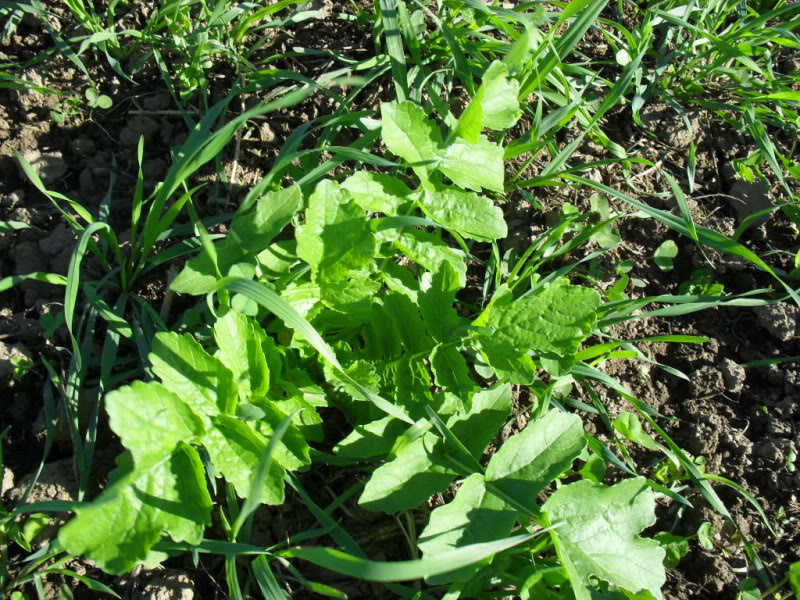
Imagine hard soils like a plate...what happens when we pour water on a plate? Pour anything on a hard surface and it's going to run off. Imagine roots trying to penetrate that hard plate, imagine the stress and energy on a plant as it's roots struggle for everything it needs, unable to go vertically where the "gold mine" lays.
Now...imagine a soft fluffy sponge...water and nutrients absorb instantly rather then running off. Tap roots of whatever we plant on loosened soils can penetrate deep into subsoil for moisture and nutrients previously "locked" beneath the hardpan or "plate" so to speak.
Radishes for deer
Brassicas and Mustards for Cover Cropping
Like field rye, radishes suppress weeds both while growing and the following year. Starting to get the picture here?
Using the right combination of crops like rye, buckwheat and radishes we can loosen soil, build the organic matter, "haul" up hidden nutrients, soak up nitrogen..and that's just the beginning! :way:
This is the new improved forage/tillage radish called Groundhog Forage radish available from Welter Seed
What is the difference between the "Groundhog" variety and the regular "oilseed radish"?
Groundhog radishes are an improved tillage variety...developed by Ampac Seed with more info at this link:GroundHog RadishGH is a tillage radish...and this pic shows the difference
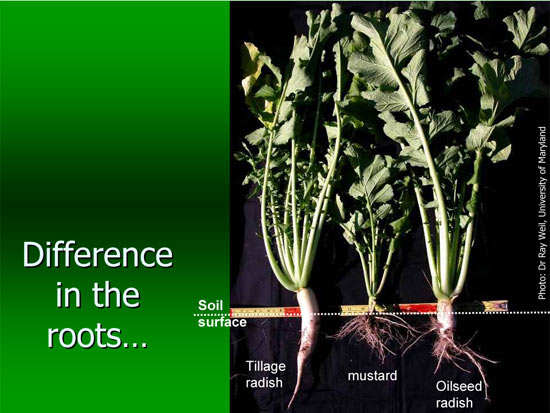
This pic shows the difference in GH versus Daikon radishes
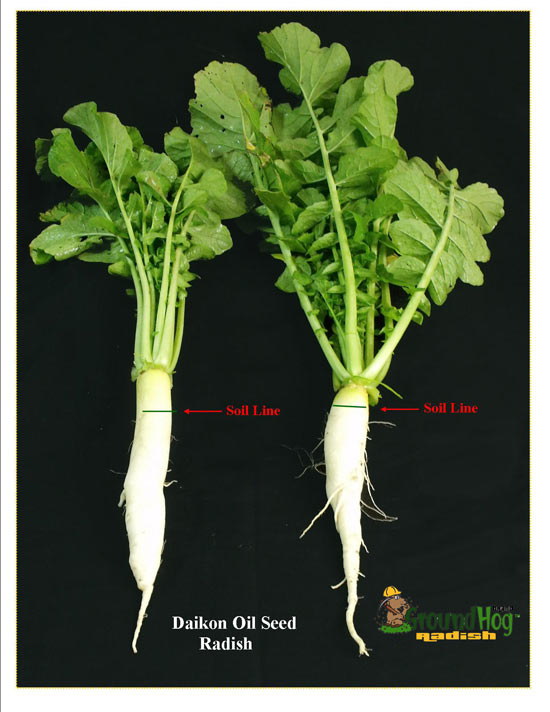
Some folks wonder how deep the GH radish grows?? Note that the tap root can go several feet deeper then the radish itself.Hard to beat for $2.65 a pound from Welter Seed!!

Earthworms and forage radish
Cedar Meadow Farm
Forage radish mixes to renovate field lanes
Tillage Radishes
FORAGE RADISH, A NEW COVER CROP
Seed isn't expensive and is planted just exactly like other summer planted brassicas.
Growing Tips
Tillage Radishes
Tillage Radish Research
Biotilling with forage radish
Cedar Meadow Farm
Overseed forage radish into soybeans
GRAZA Forage Radishes
Radishes for deep tillage
Seed is slightly over 2 bucks a pound very much like turnip and rape seed.
The seed I planted this year was Graza Radish and I don't know how it compares to Diakon Radishes at this point.
Graza Radish Seed
Welter Seed is now offering Oilseed Radish
Oilseed Radish Seed source
Albert Lea Seed Co. carries oilseed radish
Oilseed Radish Seed
Here is a source for Daikon Oil Radish and GroundHog Forage Radish
The Seed Center
Long season brassicas require a 150-220 day growing season so these we plant in the spring:
I always use both forage and root types in either short or long season mixes so that when the forage is gone they can feed on the roots well into winter.


Brassica Seed Sources:I have tested all brands and varieties of brassicas in side by side tests and have found that deer either love them all or snub their noses at them regardless of where you purchase the seed from. As with all seed involved with foodplotting there is plenty of hype and expensive advertising going on to try to convince plotters that they have they best product.
Save your money and purchase brassica seed without a "big buck" on the bag...
Here's a selection of short season brassicas that I have used with great success:

Roots...

Many of those seeds you will find in commercial mixes but I call Welters and order them by the pound for roughly $3 a pound.
Welter Seed
Maxi-Rack Seeds
nannyslayer carries these seeds in a mix called "bullseye" and they perform very well!

No roots because they are mostly forage hybrids

Biologic Maximum conatins these brassica seeds:

Maximum Roots

Tecomate Ultra Forage Mix contains the following: (note the clover in this mix didn't have a chance making this mix a poor choice!)
Tecomate Tops

No roots because there no turnips in this mix and NO clover or chicory survived making that seed a waste

The WTI Wintergreen seed arrive late even though I ordered it all the same time and didn't amount to much planted early Sept.

Here's an example of a long season brassica mix:
Long Season Brassica Seed
Cooper Seeds has both Winton Swedes and Kestrel Kale
Adams Briscoe Seed carries long season brassicas as well.
Dwarf Essex Rape


Appin Forage Turnip

Barkant Forage Turnip


Bonar Rape


Pasja Hybrid Brassica


Tyfon Forage Brassica


Purple Top Turnips - remember turnips provide late winter feed via the "root" so early grazing of the tops may not be as notable.


Planting and growing brassicas
Brassicas require plenty of nitrogen so plan on tilling in 150#'s per acre of 46-0-0 urea (46#'s of actual nitrogen per hundred pounds) Urea must be tilled in shortly after applying or before a heavy rain or you will lose most of it thru denitrication.
Brassicas DO NOT like sandy dry soil, they prefer moist loamy soils for optimum growth.
Triple 19 is a fertilizer combination of NITROGEN, POTASSIUM, AND PHOSPHORUS The "19"just means there is 19#'s in every 100#'s or 19%. There are common fertilizer mixes such as 6-24-24, 12-12-12, 19-19-19 46-0-0 etc. etc.
All the "numbers" tell you is how much of each of the 3 main elements are in a bag of fertilizer. If you buy it in bulk from an ag supply source, they can mix any combination your require. This is why we take soil tests so we know what nutrients our soils may be lacking and what might be required for the crop we'll be growing.
Sometimes you can buy fertilizers on sale at Wal-Mart, Menards, TSC and others...fertilizer is fertilizer as long as you understand what is in it.
DO NOT apply lawn fertilize containing week killers over the top of brassicas...it contains 2-4D and will kill them. Mix it in the soil and it won't be a problem. (cheaper to buy it without weedkiller however...)
Triple 19 is a good all around mix of equal amounts of N-P-K but brassicas prefer plenty of nitrogen so that's where the "300#'s" comes in. Using 300 pounds will give you 57 pounds of each element. You could get away with a 100#'s of 46-0-0 urea which is just nitrogen and does not contain the P and K elements.
at $20-25 a 50# bag, 300#'s could easily run $120-150 per acre which makes 15 bucks worth of red clover seed seem like a pretty darn good deal...
Here are some links to help you understand a little more about fertilizer and what the "numbers" mean.
About Fertilizer
NITROGEN, POTASSIUM, AND PHOSPHORUS
Fertilizer
Nutrient Topics Use the drop window to explore all types of nutrient topics and explore NPK topics including soil testing.
Nutrient Cycling & Maintaining Soil Fertility
Fertility Management in Organic Crop Systems
Nutrient Considerations for Diversified Cropping Systems
Soil Test Interpretation Guide
Soil Fertility Management
Mind Your P's and K's
You Can't Afford Not to Lime
I prefer to till down red or berseem clover or a worn out white clover patch so that the brassicas can take advantage of nitrogen released from the decomposing legumes.


During the final tillage process is a perfect time to incorporate fertlizer such as this triple 13


Eventually the tilled clover looks like this:

Brassica seed is tiny like clover seed so I use a small handheld grass seeder set on the smallest setting

Sow 3-6#'s per acre of brassica seed...use caution to NOT over seed!! :shock:

We don't want to bury the tiny seed so it's best to cultipack (or use a piece of chain link fence or a big plank)

Dual Magnum II pre-emergence herbicide can be used to control weeds:
Dual Magnum II label for brassicas
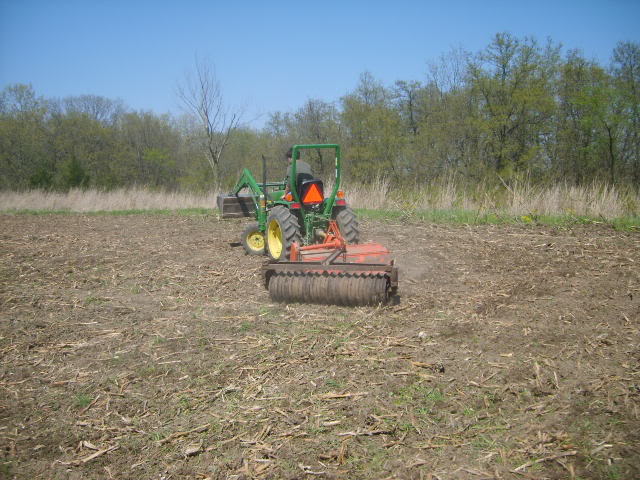
Eventually the tiny seeds begin to pop up, usually in 10-14 days depending on soil moisture


With adequate moisture they grow quickly



Deer often prefer brassicas after they have been "sweetened" by a frost but mine start on them long before that!


On good soil with plenty of moisture and nitrogen brassicas can look like this in as little as 6 weeks!

This plot contains all of varieties and brand names but can you tell which is which??

One one farm the deer decimate my brassicas early on, often well before hunting season... :roll:



You can top dress some nitrogen on just before a rain to give them a boost just before hunting season. If you use lawn fertilizer however use caution NOT to use any with weedkiller!! 2-4D will kill brassicas in the blink of an eye...



This is after top dressing N

I do not reccomend mixes or mixing clover or cereal grains with brassicas, one or the other will dominate, suffucating the other crop.
These brassicas are up to my knee and totally dominate and the red clover in the Tecomate mix never had a chance! Why pay to throw seed away??



In this case I tried adding berseem clover to a long season spring brassica planting but the berseem quickly overtook the slower growing kale and swedes



In this case oats dominated the brassicas

Here they have overtaken a mix of rye and oats, so I encourage planting them seperate and rotating crops each year.

Brassicas are reletively easy to broadcast into standing soybeans...this pic shows baby brassicas popping up in the moist soil

A few weeks later they are growing nicely

They can also be broadcast into standing corn
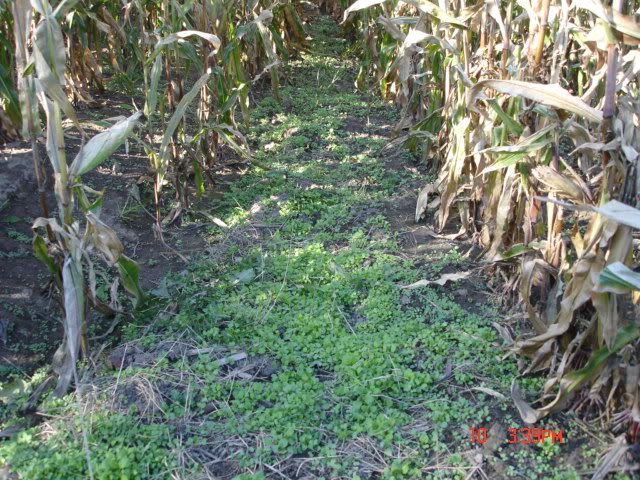
Purple Tops work very well broadcast into standing corn near the end of summer
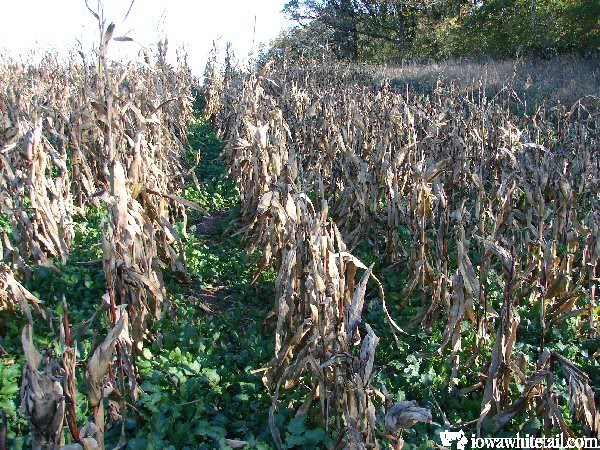
This works better on corn that has not had heavy applications of atrazine!
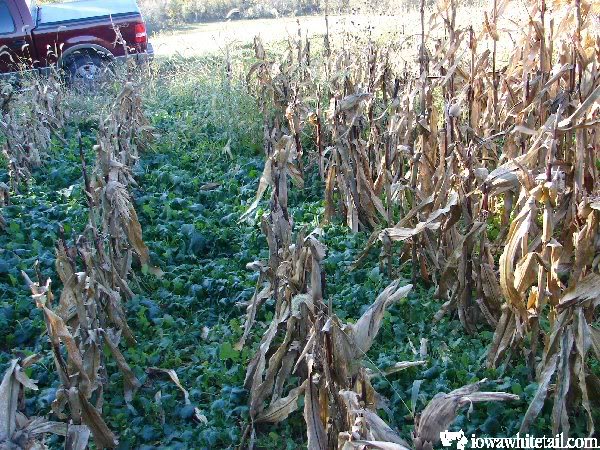
Wide rows work a little better but brassica seed is inexpensive at 2-3 bucks a pound through Welters so give it a shot!
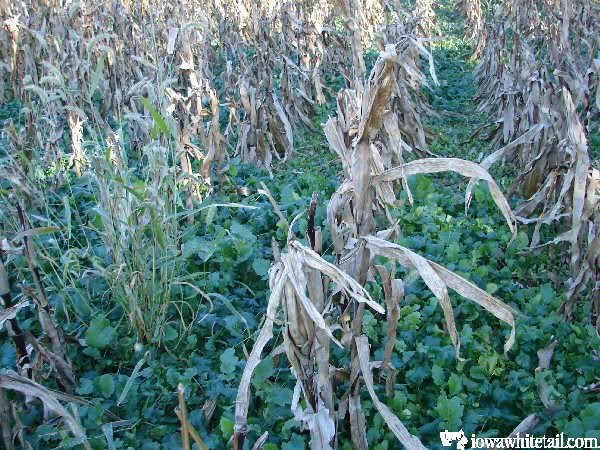
If grasses invade your brassicas they are easily controlled by spraying Select 2-EC (Arrow = generic) herbicide at 6-8 ounces per acre along with crop oil.

Here you can see the dying grass after I nuked it with Select

Brassicas can take some hard frosts but when temps drop into the single digits they start to wilt as this pic taken November 25th shows.



Plenty of turnip roots will ensure winter feed!




If deer learn to eat brassicas they won't last long and mine are usually gone on one of my farms long before Christmas


While those at the other farm remain untouched


Eventually even those get devoured when the weather gets bad enough



If you haven't tried brassicas before, give them a shot but don't "bet the farm" on them until you see how your deer react to them.
Sometimes it takes several years for deer to react to them depending on available food sources.
For a first time test, 3#'s of Dwarf Essex rape and 3#'s of Purple Top Turnips is a great and inexpensive combination. Seed light, fertilize heavily and plant late July to mid August. Till,fertilize, pack, seed, re-pack and watch em grow!
Diseases and PestsPlanting brassicas year after year in the same plot can result in disease so rotating brassicas with clover or cereal grains is the safe practice.
Brassica pests and diseases
Brassica Diseases
Brassica Pests
Allelopathic suppression of weeds
Brassicas have a unique ability to produce allelopathic chemicals in their root system that can suppress weed growth by inhibiting the ability of small seeds to germinate.
This also means that some small seeds like clover may also be suppressed so it is important to understand a little about this subject because sometimes frost seeding clover into a stand of winter killed brassicas may prove futile. It depends on the amount of growth left so if deer eat the brassicas to the ground leaving little or no root growth the fall before, there may be little or no allelopathic affects.
If deer do not eat the brassicas until late winter the affects may be strong! It is usually best to deep till the brassicas early in the spring and then re-till a week or so later and then seed an annual clover to follow the brassicas if they were uneaten.
Allelopathic suppression of weeds: a new field in need of attention
Allelopathic inhibition of germination by brassicas
Allelopathy: A Review
I use a three way rotation of clover, brassicas and a winter rye/peas/forage radish and red clover combination that allows me to rotate all of those crops to use both smothering and allelopathic chemicals to control weeds with little or no herbicide use.
I plant those three crops in strips within any size field or plot and rotate thru the strips each year. This also allows me to lower my fertilizer needs because the legumes fix nitrogen and the brassica and winter rye roots store and re-release the N the following spring... Crop Rotation
Each year the brassicas and mix are rotated while the perennial white clover remains as is but when the white clover starts to thin and needs to be rotated we rotate ALL the strips.
To prepare we start our white clover with rye the fall preceding the complete rotation, then in year 5 we turn under the old clover strips and plant brassicas. We move the rye mix to the brassicas and of course the previous rye strips are now perennial white clover.
A 5 year rotation is shown but it could be a 3 or 4 year rotation if for some reason the clover thinned earlier. ALL of the strips or blocks would have some type of clover in them during the summer months (brassicas tilled under and planted to annual clovers and red or white clovers planted with the rye)
Under this rotation our soils are NEVER bare an unproductive expect for a few days while seeds germinate. Deer are NEVER without feed...year around! We always have all of our favorite crops/plants in any plots and yet disease and pests will not be a problem.
Weeds are far less likely to be a problem either because these crops either suffocate weeds or prevent them from growing....
Brassica SeedThe mix I list above is chock full of great rape, turnip and hybrid brassica varieties but most plotters need only combine one rape and one turnip variety for great results. Rape providing early attractive forage and turnips a source of late winter feed from their highly nutritious roots.The following are seed suppliers, many of whom offer seed by the pound allowing plotters to purchase only what they need but keep in mind there may be a small handling charge or increased price when purchasing "two pounds" for instance. Always check with your local co-op to save on shipping charges as well.Dwarf Essex Rape Seed 1#
Purple Top Turnips 1#
Appin forage turnip 1#
Barkant Forage Turnip 1#
Barnapoli Rape Seed 1/2#
Pasja Hybrid Brassica 1/2#
GroundHog Forage Radish 5#
or and economical and very productive mix might be
Purple Top Turnips 3#
Dwarf Essex Rape 2#
GroundHog Forage radish 5#
Plant in mid to late July in most midwest states, or 60-90 days before your first killing frost.
Till ground, cultipack or firm soil, broadcast 5#'s per acre of brassica seed and re-cultipack.
Do NOT mix other crops (especially cereal grains) with brassicas!
Use 60-90#'s of actual nitrogen (150-200#'s of urea per acre) and 200-400#'s of 6-24-24
Welter Seed
Albert Lea Seed
Adams - Briscoe Seed Company
Ernst Seeds
MAXI-RACK Seed
Cooper Seeds
Seedland Brassica seed
Star Seed
Deer Creek Seed
Links to growing brassicas
Brassicas for fall grazing
Fall and winter grazing
Brassica Fodder Crops for Fall Grazing
Turnip
Brassicas and Mustards for Cover Cropping
Brassica types:
There are 4 basic types of brassicas that we use in food plots and those are divided into two groups:
Short season brassicas have a 60-90 growing season so we plant them in late July to early August in the midwest.
Forage RadishRape (Brassica napus L.)Rape plants are forage only with no roots such as turnips have.
Barnapoli Rape
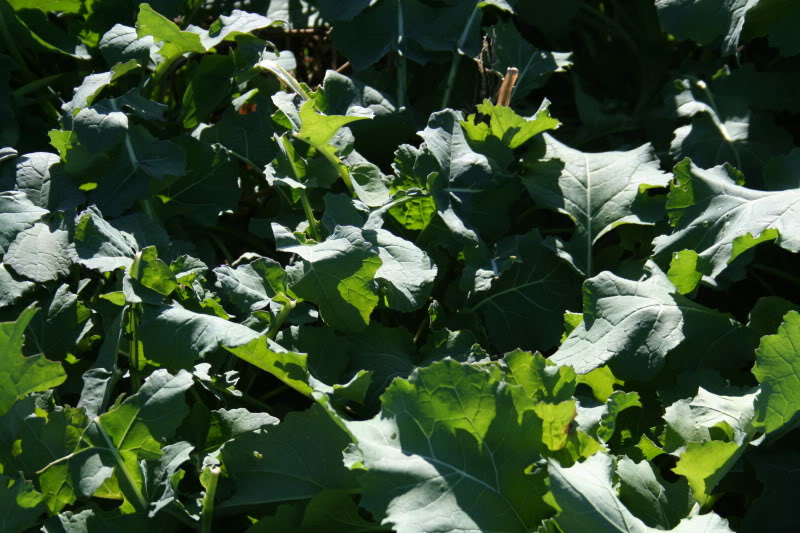
Dwarf Essex Rape commonly available and highly sought after forage
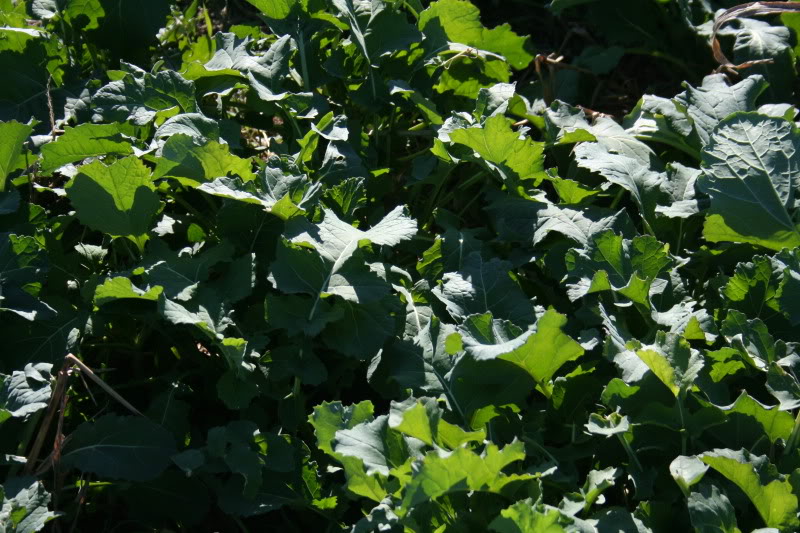
Mature forage rape is one of the best crops available for fattening lambs and flushing ewes. Rape is a multistemmed crop with fibrous roots. The stems vary in length, diameter, and in palatability to livestock. Forage yields of spring- planted rape increase until plants become physiologically mature. Growth slows or ceases at maturity and yields plateau until leaves senesce and die. Varieties differ in when this occurs, however, Rangi rape retains its leaves longer than most varieties. Generally, yields of rape varieties in Pennsylvania are maximized with two , 90-day growth periods. However, performance of Emerald and Winfred rape varieties, is best with one 180-day growth period, and yields of rape hybrids were greatest with 60 days of growth before the first harvest and a 30-day growth period before the second harvest.Turnip (Brassica rapa L.) or Turnip Hybrids
Appin Turnip Tops
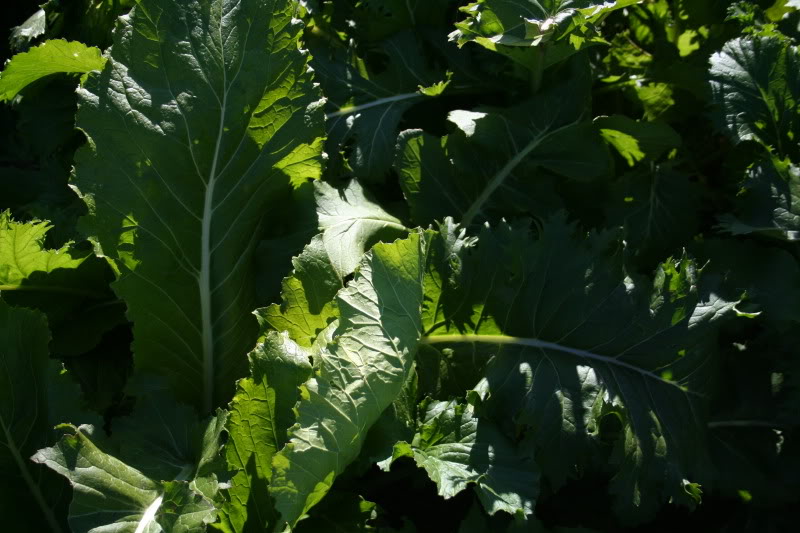
Appin turnip roots
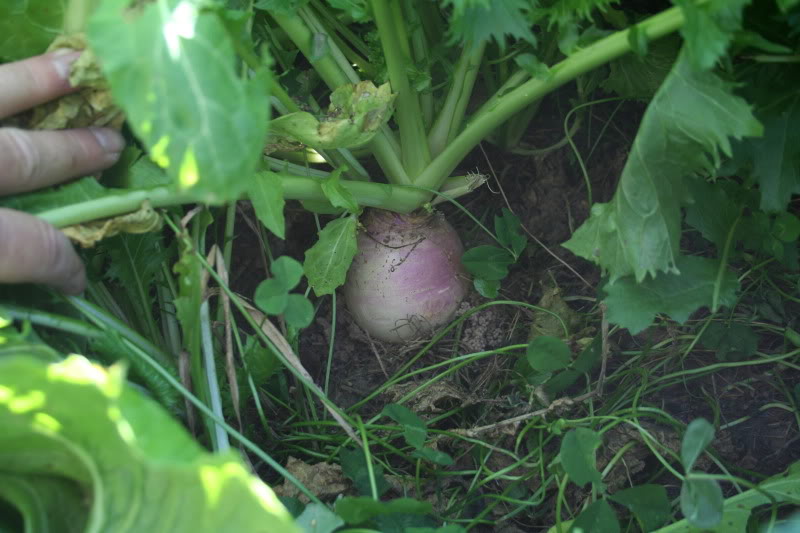
Pasja Turnip Tops
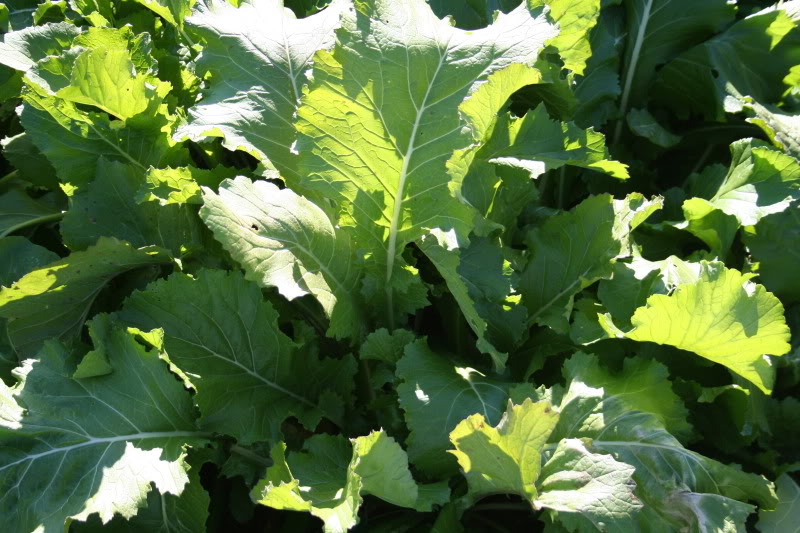
Pasja Turnip roots...these hybrids are bred primarily for forage rather then root production
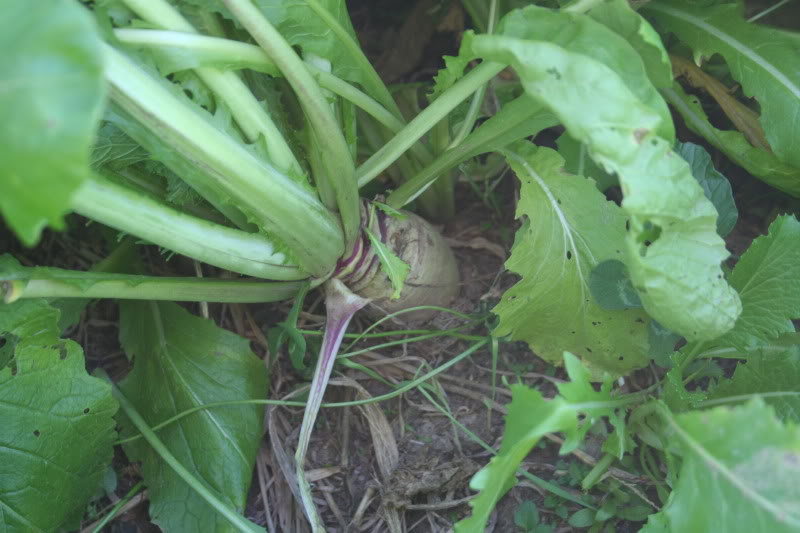
Barkant Turnip Tops
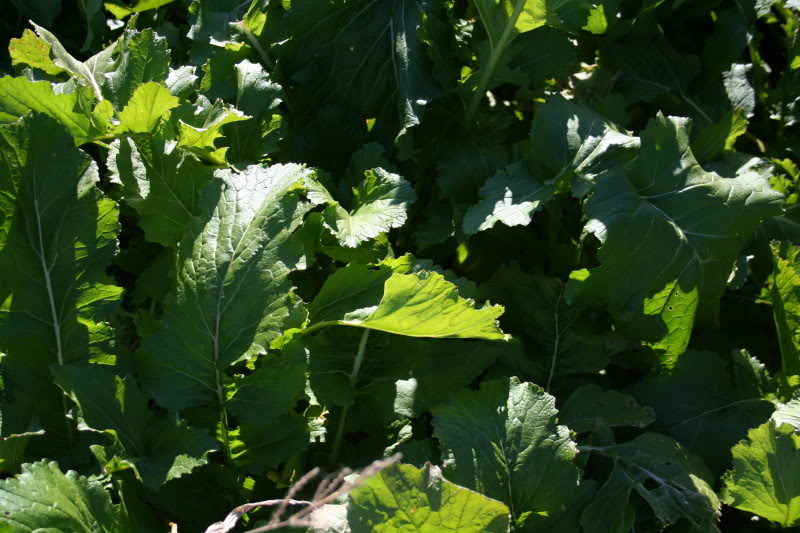
Barkant Turnip roots These turnips are bred for root production
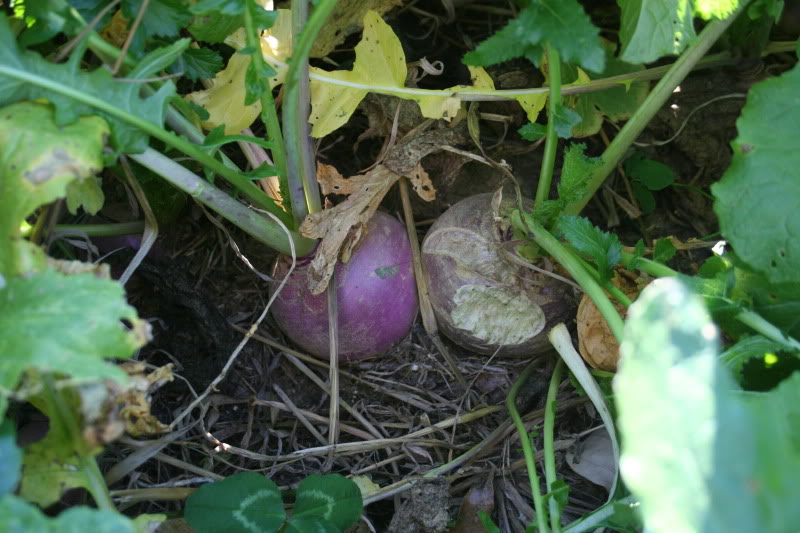
Purple Top turnips are a dependable and economical turnip with great root production

Purple Top Turnip roots Excellent root production!
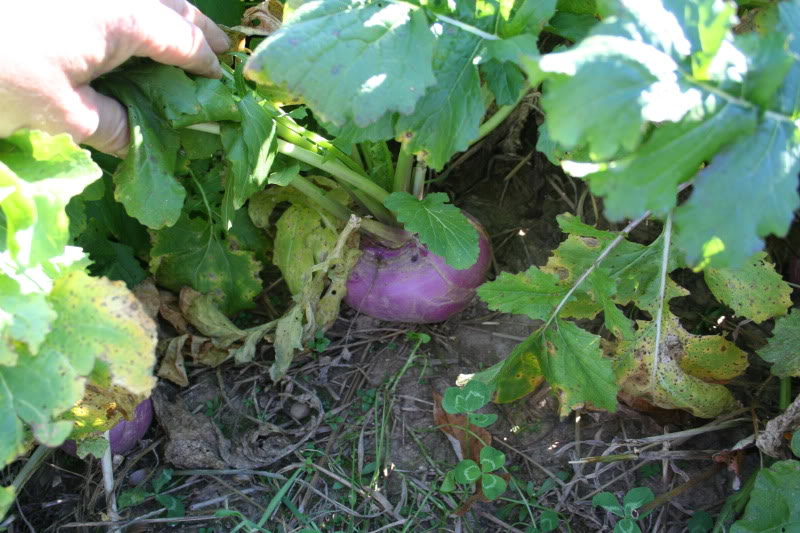
These crops grow very fast, reaching near maximum production levels in 80 to 90 days.
Studies in southwestern Pennsylvania showed that turnip can accumulate dry matter in October as fast as field corn does in August. Growing "out of season" (October/November) makes turnip a valuable crop for late fall grazing.
The proportions of tops and roots varies markedly depending on variety, crop age, and planting date. Research by the USDA Pasture Laboratory showed that turnip crops can vary from 90 percent tops/10 percent roots to 15 percent tops/85 percent roots. Some hybrids have fibrous roots which will not be readily grazed by livestock. All varieties produce primarily tops during the first 45 days of growth. Sixty to 90 days after seeding, turnip varieties such as Savannah and All Top continue to produce a high proportion of tops. During the same period, other turnip varieties have nearly equal top and root production and Purple Top has a greater root than top production.
The significance in the proportion of tops and roots is that the crude protein concentration (8 to 10%) of roots is approximately one-half of that in turnip tops. Therefore, greater root production tends to reduce the crude protein yield of the total crop. On the other hand, stockpiled tops appear to be more vulnerable to weather and pest damage than roots. Varieties differ in resistance to diseases, but this often is not evident until the crop is more than 80 days of age and the plants are reaching full production.




Heavily grazed forage radish

Tillage Radish
Ampac - Groundhog Tillage Radish
It doesn't look a whole lot different and deer and livestock forage on the leaves just like other brassicas, the difference is in the extremely long root.
Many of us have very hard pan clay soils that we are trying to improve by various soil building methods and Forage Radishes are a fantastic, simple and economical way of loosening soil, bringing up nutrients from the sub soil and feeding deer at the same time.

The tops don't look much different then other brassicas but I find deer hammer them even when they won't eat other brassicas.

The following spring however the rotted tap roots will leave deep holes that will have shattered the hard pan. Water runs into the holes, the freezing and thawing breaks up compacted soils.
In the fall though the tender foliage attracts whitetails!

Imagine hard soils like a plate...what happens when we pour water on a plate? Pour anything on a hard surface and it's going to run off. Imagine roots trying to penetrate that hard plate, imagine the stress and energy on a plant as it's roots struggle for everything it needs, unable to go vertically where the "gold mine" lays.
Now...imagine a soft fluffy sponge...water and nutrients absorb instantly rather then running off. Tap roots of whatever we plant on loosened soils can penetrate deep into subsoil for moisture and nutrients previously "locked" beneath the hardpan or "plate" so to speak.
Radishes for deer
Brassicas and Mustards for Cover Cropping
Like field rye, radishes suppress weeds both while growing and the following year. Starting to get the picture here?
Using the right combination of crops like rye, buckwheat and radishes we can loosen soil, build the organic matter, "haul" up hidden nutrients, soak up nitrogen..and that's just the beginning! :way:
This is the new improved forage/tillage radish called Groundhog Forage radish available from Welter Seed
What is the difference between the "Groundhog" variety and the regular "oilseed radish"?
Groundhog radishes are an improved tillage variety...developed by Ampac Seed with more info at this link:GroundHog RadishGH is a tillage radish...and this pic shows the difference

This pic shows the difference in GH versus Daikon radishes

Some folks wonder how deep the GH radish grows?? Note that the tap root can go several feet deeper then the radish itself.Hard to beat for $2.65 a pound from Welter Seed!!
Outstanding winter annual weed control: Radishes suppress most winter annuals. Henbit and chickweed are no match for fast growing tillage radishes.

Earthworms and forage radish
Cedar Meadow Farm
Forage radish mixes to renovate field lanes
Tillage Radishes
FORAGE RADISH, A NEW COVER CROP
Seed isn't expensive and is planted just exactly like other summer planted brassicas.
Some planting tipsSeeding rate: 8-10 lbs per acre when planted alone. Plant 1/4 to 1/2 inch deep. If dry, plant 1 inch deep.
Seed size is slightly larger than alfalfa. The alfalfa setting will be close to desired tillage radish seeding rate.
Radishes are a quick covering crop that is usually up in 4 days
There are great pics of radishes broadcast into soybeans at leaf yellowing in this link: Growing Tillage RadishesTillage radishes are extremely competitive and will outgrow most other cover crops seeded as a companion cover crop. However, seeding rates can be adjusted in order that the tillage radishes don’t out compete the other species.
Successful establishment of mixtures has been obtained by planting alternating rows with a drill that has both a legume box and grain box. We have also found the variety “Jerry” oats to do well when mixed with Tillage radishes.
Tillage radishes germinate very easily- similar to rye. They can be broadcasted on the surface and will grow if there are sufficient seeds contacting the soil and moisture is adequate. This is a cheaper method of establishment but comes with the risk of poor or uneven germination. However successful broadcast establishment has been achieved by some farmers.
Aerial seeding into soybeans before leaf drop and into standing corn is possible but it has been observed that tillage radishes do not perform as well compared to drilling. The roots just don’t seem to be as aggressive even after the crop is harvested and they can capture full sunlight. Another risk with soybeans, is if the weather doesn’t cooperate with harvest, the radishes could grow up through the canopy and cause problems with green radish leaves entering the combine
Growing Tips
All the pics and quotes come from the following links:Fertility: Tillage radishes will take up excess nitrogen after a crop. However, in order to fully express their rooting action, they need at least 60 lbs of N– accumulated either as residual or applied. In most instances, with high fertility fields, there is sufficient N left over from the previous crop. However, in low fertility fields, adding N is necessary to allow the radishes to achieve maximum rooting. Upon decomposition in the spring, N will then be released in time for utilization of a spring crop.
Tillage Radishes don’t like wet spots. Fields with a history of being wet are not a good choice to plant tillage radishes. One rule of thumb is if alfalfa can’t grow, neither will tillage radishes.
Radishes will winter kill when temperatures drop to the mid-teens on successive nights
Tillage radishes will winter kill similar to fall planted spring oats. One night in the teens will not take them out- it takes several nights in a row. Winter kill also depends on how warm it may get after a cold spell. Above normal temperatures after a few nights in the teens will allow the tillage radishes to recover until another cold snap arrives.
Tillage Radishes have an unpleasant odor when decaying. After tillage radishes are hit hard with cold weather and start to decay, they will emit an unpleasant odor-especially if warmer weather arrives. It’s no worse than manure per se, but then again for some it has caused them to investigate exactly where that “smell came from”.
Tillage Radishes
Tillage Radish Research
Biotilling with forage radish
Cedar Meadow Farm
Overseed forage radish into soybeans
GRAZA Forage Radishes
Radishes for deep tillage
Seed is slightly over 2 bucks a pound very much like turnip and rape seed.
The seed I planted this year was Graza Radish and I don't know how it compares to Diakon Radishes at this point.
Graza Radish Seed
Welter Seed is now offering Oilseed Radish
Oilseed Radish Seed source
Albert Lea Seed Co. carries oilseed radish
Oilseed Radish Seed
Here is a source for Daikon Oil Radish and GroundHog Forage Radish
The Seed Center
Long season brassicas require a 150-220 day growing season so these we plant in the spring:
Long seasons can produce more tonnage in situations where that is needed but short seasons are more commonly planted in food plots. A common mistake is planting short season brassicas to early in which case they mature, go to seed and then rot...just before hunting season! :shock: Remember to plant 60-90 days before your average first frost date for maximum yields of good quality forage.Kale (Brassica oleracea L.)Varieties of kale differ markedly in rate of establishment, stem development, time required to reach maturity, and in winterhardiness. The stemless type kale (e.g. Premier) has a faster rate of establishment than varieties which produce stems. Crop height of the stemless type is approximately 25 inches, whereas that of marrow stem kale is 60 inches with primary stems often 2 inches in diameter. Stemless kale attains maturity in approximately 90 days, allowing two crops/year, whereas varieties that develop stems require 150 to 180 days to attain maximum production. Premier has consistently survived winters in central Pennsylvania, whereas other varieties of kale usually are winter-killed in December.
Swede (Brassica napus L.)
Like turnip, swedes produce a large edible root. Yields are higher than those of turnip, but they grow slower and require 150 to 180 days to reach maximum production. Swedes usually produce a short stem (neck), but can have stems 2 1/2 feet long when grown with tall crops which shade the swede. Unfortunately, stem elongation is at the expense of root development. The variety Calder was found to be cold hardy in central Pennsylvania and thus ideal for stockpiling and late fall or early winter grazing. In general, all swede varieties are recommended for late fall grazing.
I always use both forage and root types in either short or long season mixes so that when the forage is gone they can feed on the roots well into winter.


Brassica Seed Sources:I have tested all brands and varieties of brassicas in side by side tests and have found that deer either love them all or snub their noses at them regardless of where you purchase the seed from. As with all seed involved with foodplotting there is plenty of hype and expensive advertising going on to try to convince plotters that they have they best product.
Save your money and purchase brassica seed without a "big buck" on the bag...
Here's a selection of short season brassicas that I have used with great success:
"Welter mix" of the above...Tyfon Forage Brassica
Dwarf Essex Rape Seed
Purple Top Turnips
Appin forage turnip
Barkant Forage Turnip
Barnapoli Rape Seed
Bonar Rape Seed
Pasja Hybrid Brassica

Roots...

Many of those seeds you will find in commercial mixes but I call Welters and order them by the pound for roughly $3 a pound.
Welter Seed
Maxi-Rack Seeds
nannyslayer carries these seeds in a mix called "bullseye" and they perform very well!
The Bullseye mixWinfred Brassica
Hunter Brassica

No roots because they are mostly forage hybrids

Biologic Maximum conatins these brassica seeds:
Maximum Tops29.69% Biogroa Rape
24.70% Makiraki Rape
19.70% A3 Rape
14.71% Kurow Rape
9.70% York Globe Turnip

Maximum Roots

Tecomate Ultra Forage Mix contains the following: (note the clover in this mix didn't have a chance making this mix a poor choice!)
49.97% T-Raptor Rape
14.73% Arrowleaf Clover
9.96% Lacerta Chicory
9.90% Mammouth Red Clover
9.88% Forage Feast Chicory
Tecomate Tops

No roots because there no turnips in this mix and NO clover or chicory survived making that seed a waste

The WTI Wintergreen seed arrive late even though I ordered it all the same time and didn't amount to much planted early Sept.

Here's an example of a long season brassica mix:
Long Season Brassica Seed
Cooper Seeds has both Winton Swedes and Kestrel Kale
Adams Briscoe Seed carries long season brassicas as well.
These are pics of various brassica varieties in my own plots, with Dwarf Essex Rape being one that is most commonly used in seed mixes and the very first one chosen by deer in my brassica plantings.Maris Kestrel is a full maturity leafy kale variety with short stems (150-220 days to grazing). Kestrel was bred to have a low-fiber stem with high digestibility.
Major Plus is a full maturity swede variety (from 160 days), and is characterized by its yellow-fleshed broad elliptical shaped bulb with red skin color. Major Plus is a new generation swede with high yield potential. 84% of its yield is in the bulb, providing very high energy.
Winton is a new generation late maturing swede noted for high yield potential and excellent disease resistance. Winton reaches full maturity from 180 days. With high leaf yield and excellent animal preference, Winton offers extended grazing for all livestock including dairy, beef, sheep and deer. Winton is characterized by its white-fleshed bulb, bronze skin color, and high leaf yield.
TYFON is intended for use as a high quality feed source for mid-summer or late autumn use when other cool season forages are slowing down. Tyfon should be planted at least 60 days before the grazing season to allow for adequate growth and re-growth. Plant in the spring or the fall (or in some cases farmers have planted in in the spring and then re-planted in the fall to keep a constant supply of lush nutritious forage all through the growing season).
Dwarf Essex Rape


Appin Forage Turnip

Barkant Forage Turnip


Bonar Rape


Pasja Hybrid Brassica


Tyfon Forage Brassica


Purple Top Turnips - remember turnips provide late winter feed via the "root" so early grazing of the tops may not be as notable.


Planting and growing brassicas
Brassicas require plenty of nitrogen so plan on tilling in 150#'s per acre of 46-0-0 urea (46#'s of actual nitrogen per hundred pounds) Urea must be tilled in shortly after applying or before a heavy rain or you will lose most of it thru denitrication.
Brassicas DO NOT like sandy dry soil, they prefer moist loamy soils for optimum growth.
Triple 19 is a fertilizer combination of NITROGEN, POTASSIUM, AND PHOSPHORUS The "19"just means there is 19#'s in every 100#'s or 19%. There are common fertilizer mixes such as 6-24-24, 12-12-12, 19-19-19 46-0-0 etc. etc.
All the "numbers" tell you is how much of each of the 3 main elements are in a bag of fertilizer. If you buy it in bulk from an ag supply source, they can mix any combination your require. This is why we take soil tests so we know what nutrients our soils may be lacking and what might be required for the crop we'll be growing.
Sometimes you can buy fertilizers on sale at Wal-Mart, Menards, TSC and others...fertilizer is fertilizer as long as you understand what is in it.
DO NOT apply lawn fertilize containing week killers over the top of brassicas...it contains 2-4D and will kill them. Mix it in the soil and it won't be a problem. (cheaper to buy it without weedkiller however...)
Triple 19 is a good all around mix of equal amounts of N-P-K but brassicas prefer plenty of nitrogen so that's where the "300#'s" comes in. Using 300 pounds will give you 57 pounds of each element. You could get away with a 100#'s of 46-0-0 urea which is just nitrogen and does not contain the P and K elements.
at $20-25 a 50# bag, 300#'s could easily run $120-150 per acre which makes 15 bucks worth of red clover seed seem like a pretty darn good deal...
Here are some links to help you understand a little more about fertilizer and what the "numbers" mean.
About Fertilizer
NITROGEN, POTASSIUM, AND PHOSPHORUS
Fertilizer
Nutrient Topics Use the drop window to explore all types of nutrient topics and explore NPK topics including soil testing.
Nutrient Cycling & Maintaining Soil Fertility
Fertility Management in Organic Crop Systems
Nutrient Considerations for Diversified Cropping Systems
Soil Test Interpretation Guide
Soil Fertility Management
Mind Your P's and K's
You Can't Afford Not to Lime
Brassicas also prefer a PH in the 6.5/6.8 range so be sure to soil test and apply lime as needed.Brassicas for Forage-Brassica species for forage include
rape, kale, swedes and turnips. Brassicas can be used to
break up an old pasture to be planted with an improved
species and/or to extend the grazing period into the late
fall. They are frequently planted after small grains have
been harvested. A total of 75 pounds of nitrogen is
suggested to produce good yields. Follow the
recommendations in ( P & K Recommendations ) for phosphate and potash.
Apply up to 30 pounds of nitrogen, 50 pounds of phosphate
and 50 pounds of potash in the row at planting.
Additional fertilizer should be broadcast and
incorporated before planting.
I prefer to till down red or berseem clover or a worn out white clover patch so that the brassicas can take advantage of nitrogen released from the decomposing legumes.


During the final tillage process is a perfect time to incorporate fertlizer such as this triple 13


Eventually the tilled clover looks like this:

Brassica seed is tiny like clover seed so I use a small handheld grass seeder set on the smallest setting

Sow 3-6#'s per acre of brassica seed...use caution to NOT over seed!! :shock:

We don't want to bury the tiny seed so it's best to cultipack (or use a piece of chain link fence or a big plank)

Dual Magnum II pre-emergence herbicide can be used to control weeds:
Dual Magnum II label for brassicas
Then broadcast the seed and re-pack to cover it.DAIKON RADISH, GARDEN BEET, PARSNIP, RADISH, TURNIP, RUTABAGA
Make a single broadcast application of Dual MAGNUM at 0.67 - 1.0 pt./A preplant incorporated,
preplant surface applied, or preemergence to clean-tilled soil. Use lower rates on coarsetextured
soils and higher rates on fine-textured soils. If the soil organic matter is 20% or greater
(muck soils), use Dual MAGNUM at a rate up to 1.33 pt./A. In general, the risk of crop injury
from the use of Dual MAGNUM is greater from preplant incorporated than from preplant nonincorporated
or preemergence applications. Irrigate after application to activate the herbicide if
rainfall is not expected, but use only 0.5 inches of water to incorporate the herbicide.
Precautions:
1. Excessive irrigation will increase the risk of crop injury.
2. Mechanical incorporation of Dual MAGNUM will increase the risk of crop injury.
3. It is recommended not use Dual MAGNUM if the planting operation creates a furrow or
trough over the seed-row into which rain or irrigation water will collect and thus concentrate
the herbicide over the row.
4. Not recommended on coarse textured soils with less than 1.5 % OM, as use in these soils
increases the risk of crop injury.
5. In soils with greater than 10% organic matter, weed control may be reduced.
Restrictions:
1. Make only one application of Dual MAGNUM per crop.
2. Do not apply more than 1.33 pt./A of Dual MAGNUM per crop.
3. Harvest these crops at normal timing.

Eventually the tiny seeds begin to pop up, usually in 10-14 days depending on soil moisture


With adequate moisture they grow quickly



Deer often prefer brassicas after they have been "sweetened" by a frost but mine start on them long before that!


On good soil with plenty of moisture and nitrogen brassicas can look like this in as little as 6 weeks!

This plot contains all of varieties and brand names but can you tell which is which??

One one farm the deer decimate my brassicas early on, often well before hunting season... :roll:



You can top dress some nitrogen on just before a rain to give them a boost just before hunting season. If you use lawn fertilizer however use caution NOT to use any with weedkiller!! 2-4D will kill brassicas in the blink of an eye...



This is after top dressing N

I do not reccomend mixes or mixing clover or cereal grains with brassicas, one or the other will dominate, suffucating the other crop.
These brassicas are up to my knee and totally dominate and the red clover in the Tecomate mix never had a chance! Why pay to throw seed away??



In this case I tried adding berseem clover to a long season spring brassica planting but the berseem quickly overtook the slower growing kale and swedes



In this case oats dominated the brassicas

Here they have overtaken a mix of rye and oats, so I encourage planting them seperate and rotating crops each year.

Brassicas are reletively easy to broadcast into standing soybeans...this pic shows baby brassicas popping up in the moist soil

A few weeks later they are growing nicely

They can also be broadcast into standing corn

Purple Tops work very well broadcast into standing corn near the end of summer

This works better on corn that has not had heavy applications of atrazine!

Wide rows work a little better but brassica seed is inexpensive at 2-3 bucks a pound through Welters so give it a shot!

If grasses invade your brassicas they are easily controlled by spraying Select 2-EC (Arrow = generic) herbicide at 6-8 ounces per acre along with crop oil.

Here you can see the dying grass after I nuked it with Select

Brassicas can take some hard frosts but when temps drop into the single digits they start to wilt as this pic taken November 25th shows.



Plenty of turnip roots will ensure winter feed!




If deer learn to eat brassicas they won't last long and mine are usually gone on one of my farms long before Christmas


While those at the other farm remain untouched


Eventually even those get devoured when the weather gets bad enough



If you haven't tried brassicas before, give them a shot but don't "bet the farm" on them until you see how your deer react to them.
Sometimes it takes several years for deer to react to them depending on available food sources.
For a first time test, 3#'s of Dwarf Essex rape and 3#'s of Purple Top Turnips is a great and inexpensive combination. Seed light, fertilize heavily and plant late July to mid August. Till,fertilize, pack, seed, re-pack and watch em grow!
Diseases and PestsPlanting brassicas year after year in the same plot can result in disease so rotating brassicas with clover or cereal grains is the safe practice.
Brassica pests and diseases
Brassica Diseases
Brassica Pests
Allelopathic suppression of weeds
Brassicas have a unique ability to produce allelopathic chemicals in their root system that can suppress weed growth by inhibiting the ability of small seeds to germinate.
This also means that some small seeds like clover may also be suppressed so it is important to understand a little about this subject because sometimes frost seeding clover into a stand of winter killed brassicas may prove futile. It depends on the amount of growth left so if deer eat the brassicas to the ground leaving little or no root growth the fall before, there may be little or no allelopathic affects.
If deer do not eat the brassicas until late winter the affects may be strong! It is usually best to deep till the brassicas early in the spring and then re-till a week or so later and then seed an annual clover to follow the brassicas if they were uneaten.
Allelopathic suppression of weeds: a new field in need of attention
Allelopathic inhibition of germination by brassicas
Allelopathy: A Review
I use a three way rotation of clover, brassicas and a winter rye/peas/forage radish and red clover combination that allows me to rotate all of those crops to use both smothering and allelopathic chemicals to control weeds with little or no herbicide use.
I plant those three crops in strips within any size field or plot and rotate thru the strips each year. This also allows me to lower my fertilizer needs because the legumes fix nitrogen and the brassica and winter rye roots store and re-release the N the following spring... Crop Rotation
This is kind of a good explanation of a crop rotation between white clover (C), brassicas (B) and the winter rye/oats/forage peas/forage radish/ red or white clover mix (M)Year 1 B ---> M ----C
Year 2 M ---> B ----C
Year 3 B ---> M ----C
Year 4 M ---> B ----C (plant white clover with the rye mix "M")
Year 5 M---> B ---> C ---> (the previous year clover planting becomes the new -C-)
Each year the brassicas and mix are rotated while the perennial white clover remains as is but when the white clover starts to thin and needs to be rotated we rotate ALL the strips.
To prepare we start our white clover with rye the fall preceding the complete rotation, then in year 5 we turn under the old clover strips and plant brassicas. We move the rye mix to the brassicas and of course the previous rye strips are now perennial white clover.
A 5 year rotation is shown but it could be a 3 or 4 year rotation if for some reason the clover thinned earlier. ALL of the strips or blocks would have some type of clover in them during the summer months (brassicas tilled under and planted to annual clovers and red or white clovers planted with the rye)
Under this rotation our soils are NEVER bare an unproductive expect for a few days while seeds germinate. Deer are NEVER without feed...year around! We always have all of our favorite crops/plants in any plots and yet disease and pests will not be a problem.
Weeds are far less likely to be a problem either because these crops either suffocate weeds or prevent them from growing....
Last edited:







































